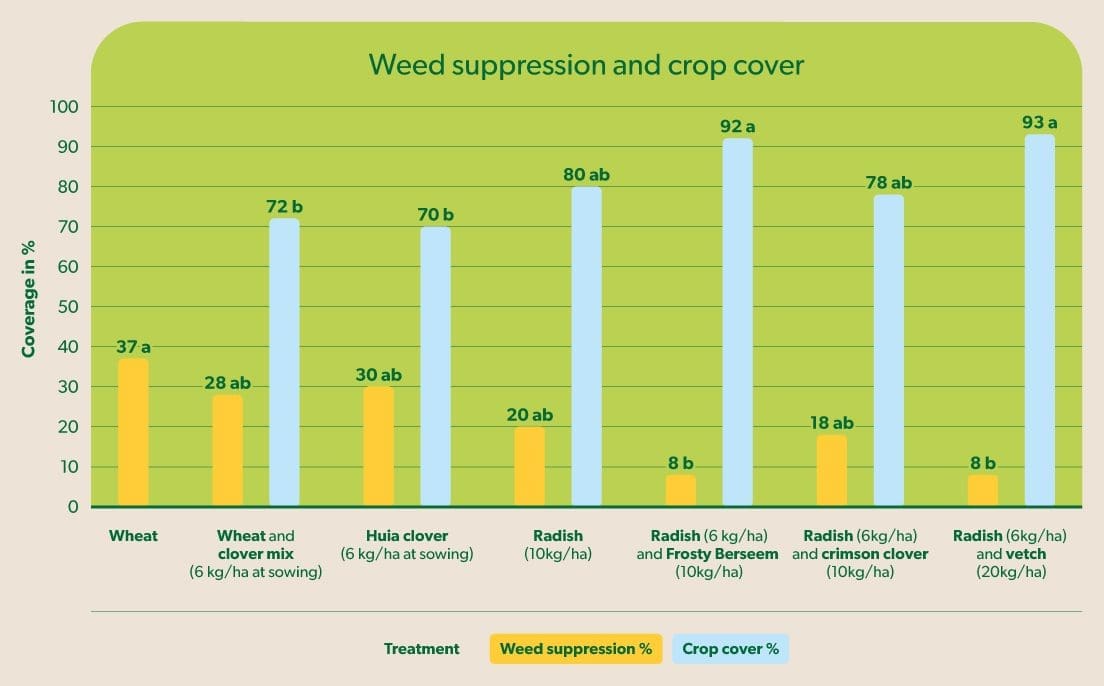
In 2024, the team at Sollio Agriculture’s research farm conducted many research projects in sustainable agriculture. We tested a smart sprayer, herbicide banding, and the use of drone technology to sow cover crops, all in an effort to reduce risk indices and improve soil health. The results are promising, both agronomically and economically.
The aim of our trials is to develop cost-effective sustainable farming practices. We’re always mindful of the requirements in the Québec government’s 2020–2030 Sustainable Agriculture Plan. But the main goal of our research projects is to equip our agri-advisors to support farmers who want to adopt more climate-resilient practices without compromising on yields.
Here are the results of the 2024 research farm trials.
1. Smart sprayer to reduce pesticide use
We tested Swiss company Ecorobotix’s ARA technology on corn and soybean crops. Equipped with 156 independent nozzles and six AI-powered multispectral cameras, this system recognizes weeds and sprays them with ultra-targeted precision.
The research team compared the performance of ARA technology with that of a conventional sprayer.
Results in corn
In corn, the results were as follows:
- Crop impact: no significant difference in yield between conventional spraying and treatment with the smart sprayer.
- Reduction in risk indices: 50% reduction in herbicide use (105 L/ha with ARA vs. 200 L/ha with the conventional sprayer).
- Effectiveness: comparable effectiveness rates for weed control, with 95% for the ARA sprayer and 99% for conventional spraying.
Results in soybeans
In soybeans, the results were as follows:
- Crop impact: no significant difference in yield between the two technologies.
- Reduction in risk indices: 30% reduction in pesticide use (132 L/ha with ARA vs. 200 L/ha with the conventional sprayer).
- Effectiveness: excellent weed control with both technologies.
These results show that smart spraying reduces pesticide use in corn and soybean crops without affecting yields or weed control.
It should be noted that the Ecorobotix smart sprayer has an optimal working speed of 7 km/h, which allows it to treat 4 ha/h, so it may not be suitable for large farms where fast application is crucial.
2. Herbicide banding
The principle of herbicide banding is quite simple: Herbicide is sprayed in a band directly over the crop rows, and weeds in the space between the rows are removed by mechanical weeding. This means weeds are targeted directly without treating the whole plot, reducing the amount of pesticide applied.
In 2023 and 2024, the team at the research farm evaluated the effectiveness of banding herbicide over 12-inch and 15-inch rows in corn and soybean crops compared with applying herbicide over the entire plot or leaving the plot untreated (the control). We also compared the yields for each method.
Trial results
For weed control, the effectiveness of banding herbicide and using mechanical weeding was comparable to applying herbicide over an entire plot.
For soybean yields, there was no significant difference between the three treatments.
In corn, whole-plot herbicide applications gave the best yields.
That last result could be due to the use of a heavy-duty cultivator with 19-inch and 21-inch tines. The cultivator may have worked deeper, which may have damaged the roots. The team will conduct a new series of trials next season to see if they can adjust the parameters to maintain the same yield as the fully treated plots.
In all cases, herbicide banding methods help reduce health and environmental risk indices by an impressive 40% and 50% respectively, with comparable effectiveness, hence the interest in doing further trials to better assess profitability.
3. Use of drone technology to sow cover crops
The aim of this research project was to compare the effectiveness of two techniques for intercropping cover crops with wheat:
-
Conventional method: sowing cover crops at the same time as wheat using a Great Plains seeder.
-
Drone seeding method: sowing cover crops when the wheat begins to change colour (around July 20) using an Agras T40 drone equipped with a seed spreader.
Trial results
The data show that intercropping cover crops has no negative effect on wheat yield, regardless of the technique used. The same is true for grain quality.
However, cover crops sown with drone technology provide significantly better crop cover and better weed suppression than those sown with the Great Plains seeder.

Sowing cover crops using innovative methods such as drone technology seems to help improve soil health and conservation.
Advice for farmers
These research projects allow us to identify the best practices for farmers in the field.
Smart sprayers, herbicide banding and the use of drone technology to sow cover crops are among the methods and technologies that are paving the way for more sustainable, cost-effective agriculture on Canadian farms.
Talk to your agri-advisor to see which practices may be worth adopting on your farm.
Article published on Sollio Agriculture’s website

